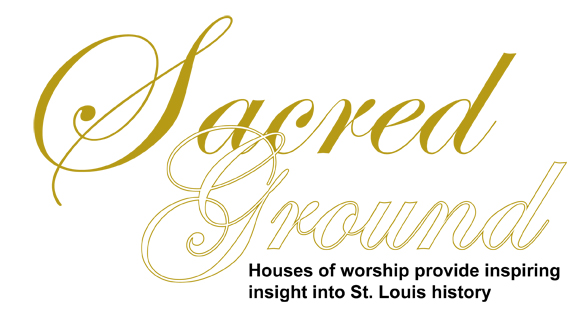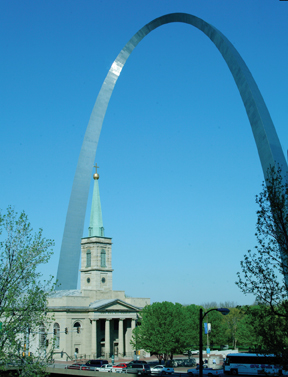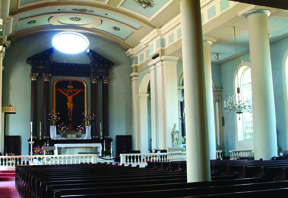
The Old Cathedral

Officially, its title today is Basilica of Saint Louis, King, but to true St. Louisans it will always be simply and lovingly known as the Old Cathedral. That, of course, is to distinguish it from the “New Cathedral” on Lindell (covered in the next section of this article).
The first “church” on the site was a tent where St. Louis’ first baptism was held in 1766. A crude log structure followed in 1770, and then a second log cabin in 1776, when the mission of St. Louis became the city’s first parish. A brick church, whose interior was never finished, followed in 1819.
St. Louis became the seat of its own diocese in 1826 and Joseph Rosati was named its first Bishop the following year. This created a need for a cathedral, and in 1831 the cornerstone was laid on the same ground—designated church land by Auguste Choteau. The elegant new cathedral, built at a cost of $63,361 was dedicated in 1834.
The cathedral’s exterior is made of limestone from Joliet, Illinois, that has weathered to a soft gray. Four Doric columns grace the portico of the classically-designed building. The pediment above the columns surprisingly bears gilded Hebrew characters.
Doric columns also appear in the interior of the cathedral with a series of five found on each side. Unlike the other churches that are featured in this article, the windows of the Old Cathedral are clear, bringing God’s natural light inside.
A unique religious feature figures in the history of the Old Cathedral. Bishop Rosati had been a classmate of Pope Gregory XVI. During a papal audience, Rosati asked that the same special indulgences attached to the seven great basilicas of Rome be granted to his cathedral on the frontier in St. Louis. Pope Gregory supposedly replied, “Unheard of” to which Rosati responded, “That’s why I want them.” To this day, the Old Cathedral still offers these indulgences.

In the 1930s, the buildings of the riverfront area were razed to make way for a planned monument to St. Louis’ role in westward expansion. The only building that was left untouched was the Old Cathedral. Today it sits serenely on its original site, framed by the Gateway Arch.
Basilica status was awarded to the Old Cathedral in 1961 by Pope John XXIII, who declared it “a treasure of the universal church.” The symbols of that status—the half open umbrella (canopeum) and the bell in the key-shaped frame (tintinnabulum)—may be seen in the rear of the basilica.
The Old Cathedral has been beautifully restored and is as classically elegant inside as it is out. The look is French with ceiling medallions in soft shades of blue, gray and white. Chandeliers feature lights that look like small taper candles. The altar is overshadowed by a somber Velasquez painting of the Crucifixion surrounded by a frieze of dark wood and topped by a clear oval window. A bishop’s chair sits on the left side of the sanctuary, marked by a small canopy.
Understated is also a word that fits the Old Cathedral. The 14 stations of the cross, a staple feature of Catholic churches, are included here in the form of small paintings. The volume of statuary and artwork is minimal compared to many other churches, and there is a special quality in what is here, not to mention a special history.
Pierre Laclede and Auguste Choteau could not have foreseen the modern multi-lane highway that runs next to their chosen sacred property or the city that stretches for many miles to the west. But their foresight does mean that today and, hopefully, for many more decades to come, the Old Cathedral will stand as a testament to those who chose to follow their dreams and their faith and build this city on the Mississippi.
Sunday obligation masses are held Saturdays at 5:30 p.m. and Sundays at 8 a.m., 10:30 a.m., noon and 5 p.m. When services are not in progress, visitors can listen to a taped recording of the history of the Cathedral. The Old Cathedral Museum and gift shop are scheduled to be open from 9:30 a.m.-2:30 p.m. daily, although this is not always the case.
